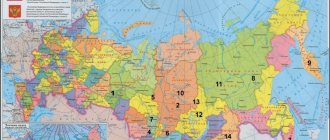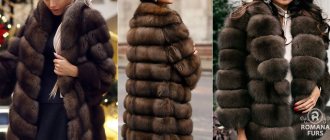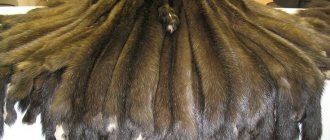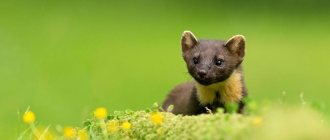In the wild there are a huge number of fur-bearing animals, the fur of which has unique properties, depending on the animal’s membership in a particular biological species. This fur is unique, has distinctive features and coloring. Features of the furs of different types of animals can be seen in Pushnin’s article. Let's get to know each other better. However, even within one species, the properties of fur can vary depending on the habitat of a particular population.
Tobolsk (1), Angara (2), Far Eastern (3), Altai (4), Yenisei (5), Sayan (6), Kuznetsk (7), Yakut (8), Kamchatka (9), Tungus (10), Ilimpisky (11), Barguzinsky (12), Vitimsky (13), Chikoysky (14)
The geographical location of a group of individuals makes adjustments not only to the seasonal habits of the animals, but also to the structure, size and color of the fur. This is best seen in the example of such a rare animal, which has very valuable fur, as the sable.
| The sable is distributed throughout the north of the Eurasian continent and on the Japanese Islands, and each of its populations has its own distinctive characteristics, which can be used to determine exactly where the animal grew up. This also applies to the quality of fur, which has its own characteristics in each population. Sable fur is unique... |
The most obvious qualitative changes in sable fur depending on its habitat can be traced by two characteristics: the color of the fur and the size of the skin. These signs are more susceptible to change than others.
Sable economy class
Tobolsk sable
| Tobolsk sable , living in the territory located between the Ural Mountains and the Ob, has a very large size and the lightest fur, which is least valued. Tobolsk sable |
Angarsk sable
| Lives east of the Yenisei Angara sable . It is distributed over a vast territory, including the right bank of the Angara and its tributaries - Podkamennaya Tunguska and Oka, and in the south it reaches the Kansk steppe. Small and light subspecies of sable, which are valued the least. Angarsk sable |
Far Eastern sable
| Far Eastern sable very small and very light, the cheapest subspecies of fur, however, within the subspecies it is divided into three more groups: Sakhalin, Ussuri and Shantar, which have minor differences in the color and size of the skin. It lives throughout the coastal region and on Sakhalin Island. Far Eastern sable |
How to distinguish sable fur from marten fur by color
Recently, manufacturers have begun to tint the marten in dark colors, thereby making it look very similar to sable .
When buying a sable fur coat, be careful. Often sellers pass off marten as sable , and less expensive sable as more expensive.
The color and processing of the skins themselves are very important here.
- Natural undyed fur coats .
- A slight tint is allowed, which does not fundamentally change anything. Not long ago, the color cake gained popularity. Tinting sable to match this color does not affect the quality of the fur itself.
- Tinted sable can be recognized by its flesh. If there is tinting, then the interior is colored - slightly gray if the tinting is light, and dark if the tinting is darker.
- You can also notice the tint on the throat spot. This striking difference sable and marten is especially noticeable. On the marten the spot becomes very light, but on the sable it becomes gray and barely noticeable.
The most fashionable, modern sable fur coats are sewn using ideal toning, while the silkiness and gray of the hairs are completely preserved. And remember the main thing - it is impossible to get gray hair artificially.
Middle class sable
On the western slopes of the Kuznetsk Alatau and in the area of the Tom mountain system, the Kuznetsk variety of sable lives, characterized by its smaller size and darker fur. However, the fur color of this subspecies is not the darkest and the size is rather average.
Altai sable
| Altai sable Its body size and, accordingly, its skin are average between Tobolsk and Kuznetsk sables, but its fur is much darker than that of both of the above varieties. The habitat of this subspecies is the taiga regions of Altai. Altai sable |
Yenisei sable
| Yenisei sable has even smaller skin sizes, but its fur is darker, which means it is more valuable. Lives in taiga areas between the Ob and Yenisei rivers. Yenisei sable |
Sayan sable
| Lives in the Sayan Mountains Sayan sable . This subspecies is slightly smaller than the Tobolsk one, has a dark color, but the underfur gives the fur a pale fawn tint, which makes the skins of this subspecies unique in terms of color. Sayan sable |
Yakut sable
| Yakut sable has the shortest fur, which is characterized by the greatest softness and silkiness. Its color is medium-dark, inferior to the darkest subspecies of sable. In terms of size, the Yakut sable is also approximately in the middle of the scale. Inhabits the upper reaches of Aladan and Zeya. Yakut sable |
Kamchatka sable
| Kamchatka sable - the largest subspecies, having very large sizes and a massive skull. Fur color varies from light to dark, but medium-colored dark brown individuals predominate. Kamchatka sable |
Tunguska sable
| The basin of the Lower and Podkamennaya Tunguska is inhabited by Tunguska sable . This animal is one of the smallest of all sables, but has a very dark fur color. In addition to these differences, due to local living conditions, the Tunguska sable acquired a less massive and shorter skull than other animals of this species, which makes it possible to identify it even to a non-specialist. |
How to distinguish sable from marten: in skins and finished product
Even at the dressing stage, these two animals have several differences and you can recognize where the sable is and where the marten is by the skin. If we talk about the difference in the skins themselves, there are three main characteristics.
- The natural color of sable is very complex. The guard hair and the down are different in color - the down is light and colored in zones (the base is lighter, the middle is darker, the tip is reddish), but the guard at the tip is dark and light at the bottom. the sable’s skin depends on its habitat – from light brown to almost black. The marten has uniform fur. Color from gray-reddish to beige-gray. Martens dark in nature.
- Tail length. If the tail is long and the hair is hard, it is a marten . The sable has a shorter tail and softer fur.
- Presence of a throat spot. What is a throat spot? The mustelid family, to which the sable , has a light spot on its neck. It is different from the rest of the skin color. This is most pronounced in the marten , the color varies from yellow to orange and even white. In sable it is almost invisible.
to distinguish sable from pine marten in the finished product. But we will tell you a few secrets so that, looking at the fur coat , you can be sure that this is a sable .
- The first and main distinguishing feature of marten is that it is tougher, slightly glassy in appearance and less shiny, compared to sable.
- The second feature is color. The color of the marten's fur is always lighter, with a reddish or yellowish tint.
- The third feature is that the marten never has gray hairs. They are almost always present on sable
The fur of a sable coat very quickly returns to its original shape and never becomes deformed.
Elite sable
Olympic sable
| North of Nizhnyaya Tunguska and east to the Lena River it is found Olympic sable . It is similar in size to the Tunguska, but its fur is even darker and its tail is shorter than that of other species. |
Barguzin sable
| It boasts one of the darkest fur colors Barguzin sable . This is the smallest subspecies of sable, and its fur is considered the most expensive, although there are subspecies that have an even darker, almost black color. Inhabits the coast of Lake Baikal and throughout the Barguzin ridge up to the upper reaches of the Angara. Barguzin sable |
Vitimsky sable
| Vitimsky sable has darker fur than the Barguzin, and the size of the skin is in the middle positions. The skins of this sable are of great value due to their color. Lives in the Lena and Upper Angara basins. |
Chikoy sable
| Chikoy sable is the darkest colored subspecies. Its jet-black fur commands the highest price on the fur market of any sable. This subspecies is one of the largest, second in size only to the Tobolsk, Altai and Kamchatka sables. Inhabits the southeastern tip of the Yablonovy Ridge. Chikoy sable |
As can be seen from the classification, in different habitats the sable has not only different skin sizes, but also different fur colors.
This is due to living conditions and the surrounding external environment, however, such intraspecific changes are fixed at the genetic level and will appear in the offspring, even if an individual of one subspecies is moved to a completely different area. Discussion of sable fur and products made from it on our forum. Sable. All the most interesting things about sable fur are here!
Beauty and practicality: the main differences between sable and marten
Why, when buying a fur coat , do women prefer sable fur ? Not only due to the high assessment of quality and prestige. When choosing a sable fur coat , you simultaneously solve two main issues - aesthetics and practicality. The beauty and aesthetics of sable are:
- noble colors and shades
- exceptional and unique natural shine
- incredible velvety softness
- fashion for all times
The convenience and practicality of sable fur lies in its three qualities. This:
- reliable protection against frost
- strength and durability of fur
- lightness, weightlessness of a fur coat
Russian Barguzin sable is a delicate silky skin, a noble shade of dark color. The almost black awn and the beautiful dark blue underfur together create a completely unique shine and fullness of the fur.
Sable has incredible quality - in fact, 80% wearability. Those who purchased a sable fur coat know that for almost twenty years it does not lose its appearance; you can wear it to fashionable events and wear it in everyday life.
Population and species status
Even in the century before last, sables could be found in vast territories, from the Pacific coast to Scandinavia. Currently, such fur-bearing animals are practically not found in many European countries. This is due to very intensive fishing in the last century, which caused a significant decline in their numbers, as well as a reduction in their habitat. As a result of such a thoughtless and massive extermination of such animals, they received the status of “on the verge of extinction.”
In order to preserve the total number of wild fur-bearing animals, some conservation measures were developed and implemented related to the artificial breeding of such animals in nature reserves with their subsequent resettlement in their natural habitat. As a result of such measures, it was possible to partially stop the process of population decline. For example, in the Troitsko-Pechersk region their numbers are such that they do not cause any particular concern. The same can be said about many other regions of our country. In 1970, the number of individuals was only 200 thousand, which was the reason for these animals being included in the International Red Book.
Interesting to know! Over the past half century, sables have successfully populated an 80-kilometer strip of dark coniferous forests that border the Ural Range, so this animal is hunted in sufficient quantities, despite the lack of government economic support.
In order to optimize the process of catching this predator, a decision was made to reorient hunters to self-catching methods. This approach makes it possible to control production volumes quite effectively, preventing mass uncontrolled destruction of individuals.
It is equally important to regulate the number of animals during non-migration seasons in order to preserve valuable fur-bearing animals on hunting grounds.
Natural enemies
In the wild, sables are hunted by larger predators - wolves, bears, lynxes, tigers, wolverines and foxes. Cubs are often carried away by owls and eagles.
Where are they found in nature?
The Barguzin sable lives in the Siberian taiga, in the Urals, in the northern reaches of the forest vegetation of the Pacific coast, on the island of Hokkaido in Japan. Every year the number of this predator decreases due to the great value of its fur. High population density has been recorded in the mountainous regions of the Sayan taiga and Kuznetsk Alatau. Sable is often found in the central part of the region, for example, in highway and forest-steppe strips, also in Chulym.
The number of these animals is scattered unevenly across these territories. Southern latitudes, including the Angara region and most of the Yenisei region, can also be called densely populated areas. Indeed, many sables are observed in dark coniferous areas. For example, in the Baykitsky and Turukhansky regions, as well as in the Yenisei taiga. In lighter coniferous thickets, the number is considered average. In the northern part of the taiga expanses, the Barguzin sable is a rare “guest”. In the forest-tundra strip up to Nikolskoye and Potapov, as well as in the eastern region up to the Kotui and Fomich rivers, settlements of mustelid representatives are observed sporadically.
The smallest numbers, if not the complete absence of these predators, were recorded in the southern zone. The reason for this, of course, is thriving poaching. Depending on the region of habitat, there are Tobolsk, Kuznetsk, Altai, Yenisei, Sayan, Angarsk, Tunguska, Ilimpiysk, Vitim, Chikoi, Yakut, Far Eastern, and Kamchatka sable.
Appearance of the beast
What does Barguzin sable look like? The color of the animal is uneven and depends on the part of the body. For example, on the head there is the darkest shade, almost black, the body can be light, from sandy yellow to calm fawn, or brown with darkening along the back and a rich spot on the throat. The first option is called fur and is used as the main raw material for all kinds of products. The second - collar is used for making shawls, hats and other items of clothing. Collars for the main product are often sewn from it.
Puberty and pregnancy
In the wild, the predator makes nests in tree hollows, scattered stones, and also in burrows among rhizomes. Reaching sexual maturity at two to three years, these representatives of mustelids reproduce for 10-11 years. The cycle of reproductive activity ends at a maximum of the 15th year of life. Predators mate in the summer, the main months being June and July. Pregnancy lasts approximately 8 months, more precisely 250-290 days, as a result of which from one to seven cubs are born. On average, this number is 3-4 puppies. The female produces offspring in northern latitudes, starting in May, in the southern regions - one month earlier (from April).
Subtleties of choice
When choosing a fur coat, it is advisable to follow these tips:
- be sure to try on the item - while trying on the item you should feel very light and comfortable; pay attention to the inside of the skins (the inner part). A clean, blemish-free and soft-to-the-touch backside is an indicator of the quality of workmanship;
- look at the seams - they must be very high quality - without gaps or stretch marks;
- smell the product - a rancid smell indicates a gross violation of the skinning technology;
- carefully inspect the skins - they should be the same color, correctly selected, and the product as a whole should have a monolithic appearance. Happy owners of Barguzin sable fur coats speak extremely positively and enthusiastically about these products. After all, this fur is capable of making a queen out of any woman.
Data
The record holder for the value of fur is, of course, the Barguzin sable. Interesting facts indicate that in the history of Russia there were times when for a product made from a given animal they gave an amount equal to the cost of an entire estate. When the demand for sable fur reached its peak, it began to be counterfeited with marten and other representatives of this family. After all, with high-quality processing of raw materials, an unenlightened buyer will not notice the difference.
The value of fur is still high today. Russia is the only supplier of sable skins on the world market. The number of animals on the territory of other states is disproportionately small, which makes it impossible to produce raw materials on an industrial scale. However, this does not exclude poaching.
Breeding sable in captivity
Breeding sable in captivity is very difficult. This animal is very mobile and requires a large territory for its life.
The cage must be equipped with a reliable bolt, and the windows should be covered with iron mesh. This animal is very savvy and will open the lock without difficulty. To create comfortable living conditions, you can put plastic toys in the cage; the animal loves to play . When breeding sable in enclosures, the female will show aggression towards the male after mating; the animals are immediately seated.
Peculiarities
This furry animal is actually a very dexterous and merciless predator that loves to settle in cedar trees, thickets, stone deposits, upper rivers and rocky areas. Sometimes he climbs the treetops. The Barguzin sable moves by jumping, which ranges from 30 to 70 cm in length. Thanks to the structure of its paws, it does not fall into the snow and deftly climbs tree branches. The animal has an excellently developed sense of smell and hearing, but its vision is weaker. The sound that this furry predator makes can be called a rumbling, vaguely reminiscent of a cat's purring.










